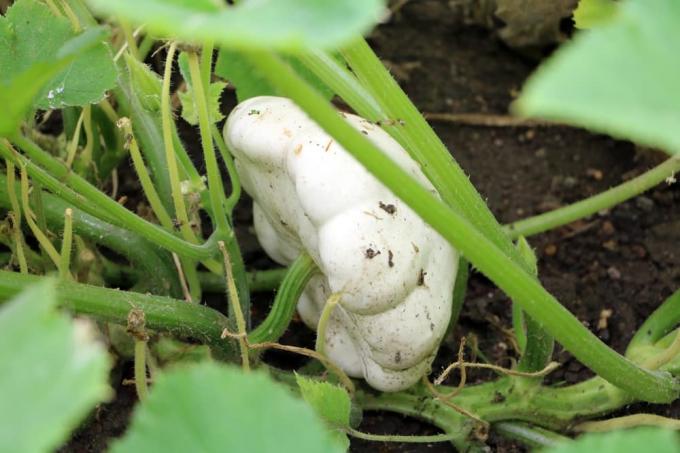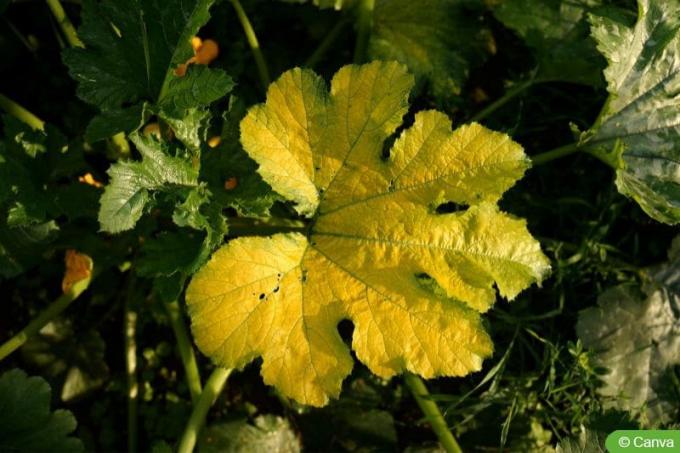

Table of contents
- Location
- substrate
- Culture in the bucket
- Cultivation in the bed
- prebreeding
- sowing
- Pour
- Fertilize
- max out
- harvest
- Conclusion
- Interesting facts about carving pumpkins
- Ornamental gourd - versatile crop
- Edible pumpkins
For the autumnal and natural decoration or the scary decoration for Halloween, as a privacy screen or Shade - Growing ornamental gourds can have numerous benefits if done right becomes. Anyone who already pays attention to the decisive requirements when sowing and treats the plants to the necessary care can enjoy the plants and fruits long before and after the harvest. With the right knowledge, cultivation is also possible without a green thumb.
Location
The sunnier and warmer, the better the ornamental pumpkin likes the location. A sheltered area near a wall or wall is favorable if they face south. A corner that is safe from too much wind and cold rain is also an option.
substrate
Even if the fruits of the ornamental pumpkins are not suitable for consumption, the plants still need plenty of nutrients - and of course they have to find them in the substrate. A humus-rich soil based on compost or enriched with well-rotted compost is ideal. Vegetable soil is also well suited as a substrate for pot culture or normal garden soil. Since the ornamental pumpkin does not tolerate waterlogging, care should also be taken to ensure that the water drains sufficiently. It is usually sufficient to mix some sand under the substrate.
Culture in the bucket
If the ornamental pumpkin is given a climbing aid, it can climb to amazing heights and also grow relatively densely. On the balcony or terrace, it therefore provides ideal protection from prying eyes, provides shade and also keeps the wind at bay. For this it must of course be cultivated in a bucket. The following points should be observed to ensure that the cultivation is successful in the very limited area:
- the bigger the better – prefer large volume containers
- If covered, make sure there is enough light
- watering daily
- Ensure water drainage
- provide a climbing aid that is at least 1.5 meters high
Tip:
Because watering the culture in the bucket represents the greatest effort in care, the soil should be covered with a thick layer of mulch. This reduces evaporation and reduces the need for watering.
Cultivation in the bed
If you are more interested in the fruits of the ornamental pumpkin and only grow the plant for this purpose, you can do without a climbing aid and choose a vegetable bed as the location instead. However, sufficient space must be planned for this, because the plants spread rapidly and can easily take up the entire bed in this way. At least one square meter should therefore be planned per ornamental pumpkin and not too many plants should be planted. In addition, the bed must be prepared accordingly. For this purpose, the soil is loosened superficially and the weeds are thoroughly removed. It is advisable to enrich the soil with well-rotted compost at least a month before sowing or planting. Again, a layer of mulch is useful to protect against evaporation. Alternatively, foil can also be pulled over the ground. This prevents drying out too quickly and therefore reduces the watering effort and water consumption, and it also keeps the soil free of weeds and the fruit clean.
prebreeding
Since the ornamental pumpkin is a sun-loving plant that does not tolerate frost, it makes sense to pre-germinate from seeds. To do this, proceed as follows:
- Pots with a diameter of about 7 cm are filled with potting soil.
- One seed is used per pot.
- The substrate is well moistened, but should not be dripping wet.
- The culture vessels are brought to a bright, warm place. For example, on a draught-free windowsill facing south or in a greenhouse. Ornamental gourds need a temperature between 20 and 24 °C to germinate.
- The substrate is kept constantly moist, even when the seeds are already beginning to germinate.
- If the young plantlets have developed other leaves in addition to the two cotyledons, they can be transplanted into a bed or bucket. However, the last frost should be waited for.

April and May are ideal times for pre-cultivation, this way the young ornamental gourds are ready to be planted out when no more frost is to be expected. However, they are not too big.
sowing
If you want to do without pre-germination, you can put the seeds directly in the bucket or bed. However, there should not be more than four seeds and two permanent plants per pot. The bed can be decided according to the available space. The ornamental pumpkin is sown in May or June, after the last frost. Again, the substrate is kept moist. In addition, a distance between the plants of at least 80, better still 100 centimeters in all directions should be ensured.
Tip:
It is more space-saving to offer climbing aids here as well.
Pour
The ornamental pumpkin is best given soft water, i.e. rain, stagnant tap or pond water without additives. It is poured directly on the trunk and not on the leaves if possible, and often in smaller quantities. The substrate must be moist at all times but never wet, because that doesn't suit the ornamental pumpkin.
Fertilize
If the soil has been prepared with compost, further fertilization can usually be dispensed with when cultivating the ornamental pumpkin. If this is necessary or if the appropriate preparation of the bed fails, compost, plant manure, vegetable fertilizer or horn shavings can be used during the flowering period. These are carefully and only very lightly hooked into the surface or spread out around the plant and distributed in the soil by the irrigation water.
max out
Since it is not important for the ornamental pumpkin to have the largest possible fruit, there is no need to go all out. If you need a few larger specimens for carvings or anything else, proceed as follows:
- If there are already fruiting bodies behind the flowers, the five strongest and largest gourds are selected per plant.
- The rest of the flowers are removed.
- Side shoots without flowers are snapped off or cut off directly on the main shoot.
With this measure, the plant concentrates its forces on the remaining fruits, causing them to grow significantly more.
harvest
In order to get decorative gourds, they should be placed on boards or foil without a climbing aid. This keeps them clean and free from unsightly stains as they grow. It is harvested when the stems of the pumpkins have become lignified and are beginning to dry out, and in any case before the first frost. If the ornamental gourds have to endure frost, they start to get mouldy.
Conclusion
Anyone who knows the requirements of the plant will find the ornamental pumpkin an easy-to-cultivate plant with numerous possible uses. Cultivation is even possible with children and it is great fun for them when they see the fruits use them for decoration after their work or carve patterns and faces into them may.
Interesting facts about carving pumpkins
- The pumpkins should be as ripe as possible and not too small to be able to process them well.
- When choosing the fruit, you should make sure that the surface of the peel is not damaged.
- Before processing, the pumpkins are stored for about 14 days so that they fully ripen and the skin becomes firm.
- Simple knives and spoons of various sizes are suitable as cutting tools.
- First, the lid is cut out of the pumpkin. To do this, the knife is guided inwards at an angle so that the lid will hold later.
- When choosing a suitable lid shape, you should consider the shape of the pumpkin.
- There are no limits to the imagination, the shape can be cut round, square or jagged.
- The flesh is then scraped out with a spoon.
- The side wall should not be damaged and should remain at least 2 cm thick.
- Stencils can also be used for the faces. This can be transferred to the pumpkin with small needles or a pen.
- The face is carved out with a knife. Then all interfaces are smoothed with a cloth.
- A tea or LCD light can be placed inside the gourd to illuminate.
- The illuminated pumpkin comes into its own on windowsills, in front of house entrances or fence walls.
Ornamental gourd - versatile crop
The pumpkin is not only a popular medicinal and garden fruit, but also delights many craft enthusiasts, especially in autumn. For example, it can be used as a flower vase when the pumpkin is cut out and cleaned. Decorated with flowers and fruits such as rose hips, chestnuts or ornamental apples, the ornamental pumpkin becomes a successful autumn decoration. The inside of the pumpkin can also be lined with floral mass beforehand. In this way, the flowers can easily find support. The flower-filled pumpkin vase is primarily suitable for table decorations indoors and outdoors or as a small gift.
Edible pumpkins
The pulp of the pumpkins can be used for a variety of dishes if the fruit is edible. If you are not sure, you can recognize edible pumpkins by the taste test. Inedible fruits contain bitter substances and taste accordingly. The bitter substances in the inedible fruits are harmful to health and should therefore not be eaten under any circumstances.
 garden editorial
garden editorial I write about everything that interests me in my garden.
Learn more about pumpkins

Zucchini fruits rot on the plant: what to do?
Sometimes a young zucchini fruit suddenly stops growing. At the same time it becomes yellow and rotten from the top. Read here how you can save your harvest if the fruits of your zucchini are rotting on the plant.

Harvesting butternut squash: when is it ripe?
Rich yellow flesh and a pear-like shape characterize the butternut squash. If you have enough space for the fast-growing plants, you will be rewarded with many tasty fruits. When is the butternut squash ready for harvest?

Yellow leaves on zucchini: what to do?
Zucchini planted in the garden usually develop so luxuriantly that there is often a veritable glut of zucchini. However, if the zucchini gets yellow leaves, you should consider location, care and diseases as causes and act immediately.

Zucchini: remove male flowers?
Zucchini form female and male flowers on one plant. The male flowers are important for pollination and thus fruit formation. The question often arises as to what the advantages and disadvantages are after removing the flowers.

15 good neighbors of pumpkin | mixed culture
The cultivation of pumpkins is effectively supported by the right mixed culture. Good neighbors protect against pests, can be used as a natural climbing aid and optimize the nutrient balance in the bed. Pumpkins can be cultivated much more successfully this way.

Grow your own luffa cucumber 9 tips for the sponge gourd
Although the luffa cucumber comes from the tropics, it can also be grown locally. However, the sponge gourd is dependent on certain conditions when it comes to location and care, with these tips you will have a rich harvest.



